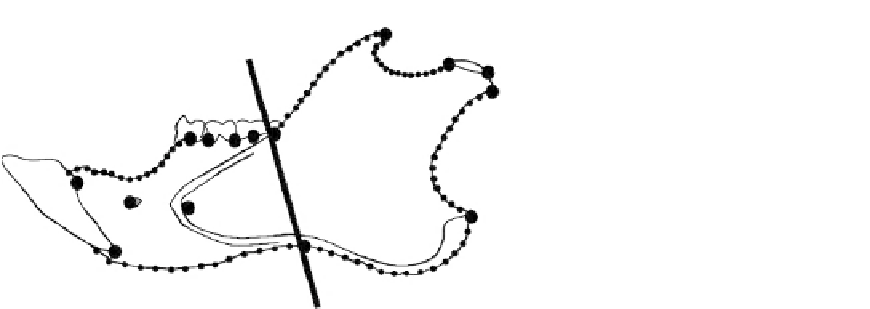Biology Reference
In-Depth Information
FIGURE 7.5
Subdivision of the mandi-
ble into two putative functional and devel-
opmental modules.
8
9
10
12
567
13
15
2
3
4
11
1
14
of independence between blocks is rejected (P
0.001) by a permutation test. SA1 explains
46.6% of the covariance between blocks and the correlation between scores is 0.93. The
dominant axis of covariation between the two blocks is shown in
Figure 7.6A
, which can
be compared to the dominant axis of variation (PC1) of the mandible (
Figure 7.6B
). Doing
the analysis the second way isolates the covariation due specifically to joint changes in
shape within each subset, produces a lower RV of just 0.302, which is still a moderately
high value for an R
2
, and this too is statistically significant (P
,
0.001). SA1, however,
accounts for just 40.1% of the covariance and the correlation between the scores is 0.74.
The pictures (
Figure 7.7
) show the dominant axis of covariation between the two blocks,
the paired SA1s.
,
Using PLS to Relate Shape to Ecological Factors
Several studies have used PLS to analyze the relationship between shape and environ-
mental factors, both abiotic and biotic (
Fadda and Corti, 1998; Ruber and Adams, 2001;
Monteiro et al., 2003; Arif et al., 2007; Pulcini et al., 2008; Fornell et al., 2010; McGuire,
2010; Noback et al., 2011
). We single out three of them to show how such analyses can be
conducted, focusing on the environmental variables.
Cichlid Body Shape and the Biotic Environment: The Relationship Between Body
Shape and Trophic Morphology
Ruber and Adams (2001)
investigated the relationship between body shape and trophic
morphology in Lake Tanganyika cichlids. These cichlids are noted for their morphological
diversity, and phylogenetic studies have revealed extensive convergence in trophic specia-
lizations, especially the specializations of their dentitions. Ruber and Adams asked
whether other body shape covaries with trophic morphology, specifically, with the special-
ized dentitions. They sampled body shape by 14 landmarks on the external morphology of
these fishes from 17 populations from four lineages, which were divided into phylogeo-
graphic clades. The landmarks comprise the first block of data, the second consists of four
morphological variables that previous studies had shown to be correlated with trophic
morphology: (1) gape width; (2) interorbital width; (3) oral tooth counts of all erupted
teeth on the premaxillary; and (4) dental bones. Thus, the morphological variables are


